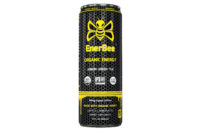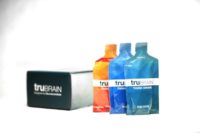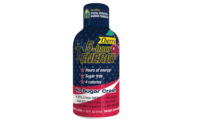Energy positioning from other segments impacts energy category
Natural and organic varieties remain niche, but offer growth options



5-hour Energy is exploring more ways to reach consumers. Earlier this year, it released a limited-time Cherry variety and launched an online mixology contest. (Image courtesy of Living Essentials LLC)





As beverage manufacturers get more creative in their product development, more beverages seem to be blurring category lines. One category that has been both aided and challenged by this multi-platform approach is the energy drink category.
Jonas Feliciano, beverage analyst for Chicago-based Euromonitor International, notes that non-alcohol beverages typically are broken into three categories: hydration, refreshment and function. Hydrating beverages typically consist of bottled waters, isotonics and sports drinks, while refreshment beverages include juices, carbonated soft drinks (CSDs), ready-to-drink (RTD) teas, etc. The function category traditionally includes energy drinks and various functional waters, he explains. However, innovation from energy drink manufacturers has allowed the category to capitalize on the hydration and refreshment segments as well, he says.
“There’s an element of refreshment now with these flavored energy drinks,” Feliciano says. “Red Bull Editions is a perfect example of that, and there’s even an element of hydration when you look at a product like Monster Rehab, [which] contains a number of electrolytes. Arnold Palmer Drive is another one that sort of straddles all these different categories with refreshment with its taste, function, inclusion of high levels of caffeine, and use of water for that hydration element.”
However, energy drink manufacturers are not the only ones who are finding a way to combine these different segments. “The fact that different manufacturers in different categories are playing with energy, the concept of what is an energy drink versus what is a CSD or a juice or an RTD beverage with an energy component, I think, is going to continue to blur as this idea of hydration, refreshment and function all sort of turn into an overall soft drink experience,” Feliciano says.
Last year, Las Vegas-based Xyience capitalized on this trend by launching its Xenergy + line, which includes Xenergy + Hydration, Xenergy + Tea and Xenergy + Lemonade. Xenergy + Hydration is caffeine free, but the other two varieties include 10 mg of caffeine in each ounce, the company says.
Alex Beckett, global food and drink analyst for London-based Mintel, also calls attention to these blurring boundaries and cautions the impact this could have on the energy category. “Functional waters containing energy ingredients are a threat, having the health and hydration halo of water, while juices are also embracing vitamins’ functionality and adding caffeine to convey an energy appeal, as seen with Tropicana Energy, [which launched in the United Kingdom],” he says.
Beckett also notes that energy drink manufacturers could look to expand their products’ drinking occasions to widen their audience bases. “The aging workforce presents new opportunities,” he says. “In the U.K., for example, over-65s are more interested than the younger groups in seeing healthier energy drink variants with natural colorings [and] flavors, an attitude which could inspire new approaches in the U.S.”
Natural solution
The concept of natural within the energy drinks market is one that could appeal to both consumers and retailers, experts note.
“Because of competition with other beverage categories, more and more people are looking in terms of innovation and ways to make themselves unique,” Euromonitor’s Feliciano says. “The idea of natural energy is one way to go and is seeing a little more pick-up, but we’ve yet to see a really strong consumer response from it.”
Feliciano notes that Seattle-based Starbucks Coffee Co. is in a strong position in this category with its Starbucks Refreshers line. Originally launched in 2012 through the North American Coffee Partnership with Purchase, N.Y.-based PepsiCo Inc., the company reformulated and repackaged the carbonated RTD beverages earlier this year. The products still contain real fruit juice, B vitamins, ginseng and green coffee extract but have added sugar to optimize the taste profile, the company says. This new formulation increased the calorie count from 60 to 90 in each serving. The company also added a Blueberry Acai variety to complement its Strawberry Lemonade and Raspberry Pomegranate offerings.
The Coca-Cola Co., Atlanta, also has shown that it is noticing the increased consumer awareness of natural energy sources with its release of vitaminwater energy. The lightly carbonated beverages feature a natural energy boost from green coffee bean extract, which provides 80 mg of caffeine, and are available in Strawberry Lime, Berry Punch, Orange Mango and Raspberry Citrus flavors.
But manufacturers also are going a step further with their innovation by developing energy drinks that are made with U.S. Department of Agriculture (USDA) certified organic ingredients. Marquis Beverages, Los Angeles, introduced its Marquis O3 earlier this year. The drinks are sweetened with stevia, resulting in a calorie- and sugar-free formulation, and source their energy from yerba mate, green tea and B vitamins. Marquis O3 beverages also are GMO free, gluten free, taurine free and vegan.
Utilizing natural and organic claims can be an effective way of marketing an energy drink, Mintel’s Beckett notes. However, he adds that manufacturers need to be sure their ingredients meet the parameters associated with those terms.
“Using words like ‘organic’ or ‘natural’ can help energy drinks convey a more wholesome image, although brands shouldn’t underestimate consumers’ ability to research the true naturalness of ingredients that are at their peril,” he says.
Euromonitor’s Feliciano adds that the natural and organic segment of energy drinks could pose a challenge to the category’s largest players — Fuschl Am See, Austria-based Red Bull and Corona, Calif.-based Monster Beverage Corp. — because they currently do not have products that play to that consumer base. However, he adds that the audiences for these brands contrast with that of Starbucks, which has a strong position in the segment.
“When you consider the average Starbucks consumer, someone who would be looking for a natural energy beverage, and compare the average Monster or Red Bull user, those are very different types of consumers,” he says. “One is more concerned about health and wellness, and the other one is really more concerned about the functionality and the efficacy of their energy drinks.”
Although the natural and organic energy drink user comes from a smaller base, it still could be a focus for beverage-makers in the future. “It’s one where it’s still very niche, but there’s a lot of interest because it can tap into a different consumer segment that the big players in energy drinks have coveted and wanted to tap into for some time,” Feliciano says.
Full of flavor
In addition to natural and organic energy, today’s consumers are interested in flavorful energy drinks, Feliciano notes.
“I think that really is not necessarily the innovation of the future, but the innovation of now,” he says. “If you’re not into flavors right now, there’s some difficulty in reaching all of those consumers we’re talking about.”
He adds that these flavor extensions can be important for retailers as they deal with competition from online portals and a decrease in overall soft drink consumption. For instance, Monster's Rehab and Ultra Zero lines and Red Bull's Editions line are just some flavor extensions in the category that continue to gain market share. Red Bull recently added a limited-edition variety to the lineup. Red Bull Summer Edition is a tropical-fruit-flavored energy drink available exclusively at 7-Eleven during July and August.
Calling the shots
A smaller portion of the pie, energy shots account for roughly $1.2 billion of the overall $10.2 billion energy drink category, according Chicago-based Information Resources Inc. (IRI) data, measuring multi-outlets during the 52 weeks ending June 15. Although it significantly trails the nearly $9 billion non-aseptic energy drink sub-category, energy shots still are the second-largest segment within the category. However, the segment has faced its share of challenges within the past year.
“Energy shot growth has slowed in the last year due in large part to maturation,” says Chris Schmidt, industry analyst for consumer health at Euromonitor. “The products have reached nearly ubiquitous distribution and consumer awareness. 5-hour Energy, in particular, seems to be dropping off, as it has lost its novelty luster and is becoming something of a commodity brand.”
Although energy shots have experienced contraction within the last year, it is not a result of struggling to evolve with the consumer audience. “It’s hard to say whether there’s a core consumer group for energy shots anymore,” Schmidt says. “At first, they were positioned as the adult version of flashy energy drinks, but that’s not really the case anymore.”
For instance, SK Energy, a brand of New York-based Pure Growth Partners, intentionally targets adult millennial consumers to set itself apart from 5-hour Energy, Schmidt explains.
Segment leader Farmington Hills, Mich.-based Living Essentials LLC’s 5-hour Energy brand also has shifted its focus to appeal to a broader audience, Schmidt notes. “For its part, 5-hour Energy has also started to move away from older consumers in its advertising,” he says. “It has focused a lot of TV advertising of late on athletes, including the ad it ran during the World Cup featuring Mexican soccer player Oribe Peralta.”
Appealing to consumers outside of the sports and nutrition demographic, 5-hour Energy also launched its “Yummification” video contest, which invites fans to create a video of their favorite way to mix a 5-hour Energy shot with an everyday beverage.
The brand also has been no stranger to flavor expansions. In support of military causes, 5-hour Energy released a limited-time Cherry variety from May through July this year. As part of the promotion, Living Essentials donated $0.05 from the sale of every specially marked red, white and blue bottle of Cherry 5-hour Energy to the Special Operations Warrior Foundation.
Although energy has been at the core of the messages surrounding energy shots, Euromonitor’s Schmidt has noticed that some marketing also focuses on claims or cognitive effects. This approach likely will be a key component in advertising going forward as the segment looks to recover from its contraction.
“The huge growth of the mid-to-late 2000s will be a thing of the past,” Schmidt says. “The products are becoming commoditized, and producers will struggle to distinguish their products in the future. I think we’ll see more focus on advertising [of] the functional benefits of energy, like focus and concentration.”
Highlighting this trend, Dana Point, Calif.-based Rushmore Essentials offers its RE energy shots, which are designed to provide sustained and long-lasting health benefits, according to the company. Available in four varieties — REshape, REfocus, REbuild and REvive — the dietary supplements contain a proprietary antioxidant blend to support their functionalities.
What the future holds
Although the overall energy drinks category was up 4.6 percent to $10.2 billion in the 52 weeks ending June 15, according to IRI data, this single-digit increase is in contrast to double-digit increases in years past, experts note.
“We may finally be entering the days of product maturation,” Euromonitor’s Feliciano says. “The segment has really grown because of its ability to sort of tap into new consumers to increase household penetration.”
Mintel’s Beckett adds that between 2011 and 2013, U.S. energy drink sales increased 34 percent to reach $8.5 billion, while shots increased 1.9 percent for
$1.6 billion. The category also saw energy drink mixes gain attention through Northfield, Ill.-based Kraft Foods Group’s Mio Energy, which garnered sales of $1.2 billion in 2013, he notes.
Taking this into account, the market research firm forecasts that the U.S. energy drink category will rise from its estimated $11.3 billion in 2013 sales to $18 billion in 2018, according to its August 2013 report “Energy Drinks – US.”
Looking for a reprint of this article?
From high-res PDFs to custom plaques, order your copy today!










